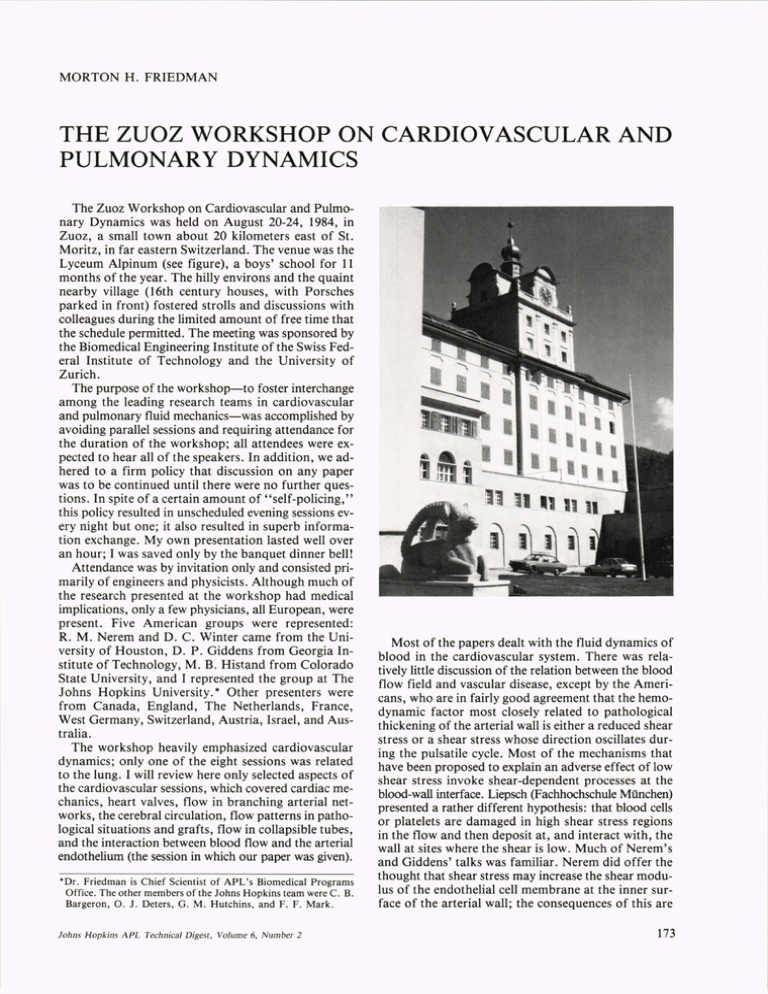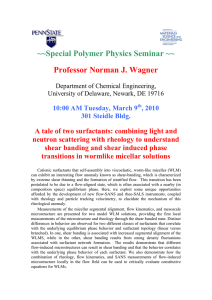THE ZUOZ WORKSHOP ON CARDIOVASCULAR AND PULMONARY DYNAMICS
advertisement

MORTON H . FRIEDMAN THE ZUOZ WORKSHOP ON CARDIOVASCULAR AND PULMONARY DYNAMICS The Zuoz Workshop on Cardiovascular and Pulmonary Dynamics was held on August 20-24, 1984, in Zuoz, a small town about 20 kilometers east of St. Moritz, in far eastern Switzerland. The venue was the Lyceum Alpinum (see figure), a boys' school for 11 months of the year. The hilly environs and the quaint nearby village (16th century houses, with Porsches parked in front) fostered strolls and discussions with colleagues during the limited amount of free time that the schedule permitted. The meeting was sponsored by the Biomedical Engineering Institute of the Swiss Federal Institute of Technology and the University of Zurich. The purpose of the workshop-to foster interchange among the leading research teams in cardiovascular and pulmonary fluid mechanics-was accomplished by avoiding parallel sessions and requiring attendance for the duration of the workshop; all attendees were expected to hear all of the speakers. In addition, we adhered to a firm policy that discussion on any paper was to be continued until there were no further questions. In spite of a certain amount of "self-policing," this policy resulted in unscheduled evening sessions every night but one; it also resulted in superb information exchange. My own presentation lasted well over an hour; I was saved only by the banquet dinner bell! Attendance was by invitation only and consisted primarily of engineers and physicists. Although much of the research presented at the workshop had medical implications, only a few physicians, all European, were present. Five American groups were represented: R. M. Nerem and D. C. Winter came from the University of Houston, D. P. Giddens from Georgia Institute of Technology, M. B. Histand from Colorado State University, and I represented the group at The Johns Hopkins University. * Other presenters were from Canada, England, The Netherlands, France, West Germany, Switzerland, Austria, Israel, and Australia. The workshop heavily emphasized cardiovascular dynamics; only one of the eight sessions was related to the lung. I will review here only selected aspects of the cardiovascular sessions, which covered cardiac mechanics, heart valves, flow in branching arterial networks, the cerebral circulation, flow patterns in pathological situations and grafts, flow in collapsible tubes, and the interaction between blood flow and the arterial endothelium (the session in which our paper was given). -Dr. Friedman is Chief Scientist of APL's Biomedical Programs Office. The other members of the Johns Hopkins team were C. B. Bargeron, O. J. Deters, G. M. Hutchins, and F. F . Mark . fohns Hopkin s APL Technical Digest, Volume 6, Number 2 Most of the papers dealt with the fluid dynamics of blood in the cardiovascular system. There was relatively little discussion of the relation between the blood flow field and vascular disease, except by the Americans, who are in fairly good agreement that the hel!lOdynamic factor most closely related to pathologIcal thickening of the arterial wall is either a reduced shear stress or a shear stress whose direction oscillates during the pulsatile cycle. Most of the mechanisms that have been proposed to explain an adverse effect of low shear stress invoke shear-dependent processes at the blood-wall interface. Liepsch (Fachhochschule Miinchen) presented a rather different hypothesis: that blood cells or platelets are damaged in high shear stress regions in the flow and then deposit at, and interact with, the wall at sites where the shear is low. Much of Nerem's and Giddens' talks was familiar. Nerem did offer the thought that shear stress may increase the shear modulus of the endothelial cell membrane at the inner surface of the arterial wall; the consequences of this are 173 M. H. Friedman - Workshop on Cardiovascular and Pulmonary Dynamics unclear. He also had a preliminary result suggesting that pressure oscillations enhance mitosis and migration of the cells. There was not much that was new in the area of experimental techniques, except with respect to working fluids, as will be described later. Several investigators are using physiological flow generators that reproduce physiological pressures as well. Morvan and Cassot's (INSERM/Marseille) device uses a balloon "ventricle" inside a rigid box, driven by a time-varying external pressure in the box. Compliance resulting from arterial elasticity is mimicked by an adjustable surge tank (windkessel) in the line; an adjustable series resistance, presumably modeling the peripheral vascular resistance, is also used. An interesting method of following the diameter of pulsating elastic tubes was described by Rieu et al., also from Marseille; the technique uses ultrasonic crystals mounted in the wall at opposite ends of a diameter. In the anemometry area, Liepsch claimed that, with a 50-millimeter focal length lens, he could measure velocities by laser Doppler anemometry 20 micrometers from the wall of a flow channel. Experimental studies of the effect of arterial elasticity on the pulsatile flow field were reported by Liepsch. Using rigid and elastic models of a femoral artery bifurcation, he found that the transient separation zone across from the entrance to a sharply angulating branch, seen in rigid models, is absent when the model is elastic. In the elastic branch, the velocity at the site is small but does not reverse. The peak velocities in the elastic model were approximately 25 percent below those measured in the corresponding rigid model; the models have uniform wall thicknesses. Liepsch is now preparing a cast whose compliance varies longitudinally, as does that of real arteries. Another arterial property, viscoelasticity, is to be simulated by Morin et al. (Poitiers), who are fabricating models from an appropriately viscoelastic silicone rubber. There is still interest in the effects of blood rheology on hemodynamics in large vessels, and Liepsch gave a summary of his work in this area. He has used a variety of working fluids to simulate the rheology of blood, one of them being a mixture of a polyacrylamide solution and dimethyl sulfoxide. He also has devised a solution that not only mimics blood rheology, but also has the same refractive index as his casts, allowing him to measure velocities by laser Doppler anemometry. The mixture includes the polyacrylamides, AP30 and AP45, isopropyl alcohol, and water, to match rheology; plus calcium or magnesium chloride and glycerol, to raise the refractive index. Schmitz and Merzkirch (Essen) use a mixture of milling yellow dye, sodium sulfate, and sodium chloride in water, a solution that has a non-Newtonian viscosity paralleling that of blood (but 3.6 times higher) at shear rates up to 250 reciprocal seconds. Liepsch believes that non-Newtonian effects are important in large arteries at sites such as bifurcations and bends where there is flow reversal. For instance, in a cast containing a sharply angulating (90°) daughter branch, he finds a small region of flow separation 174 on the side of the flow divider that faces the continuing vessel. This separated region persists throughout the pulsatile cycle. No separation is seen at the site when the working fluid is Newtonian. Niederer (Zurich) pointed out that blood rheology obtained from steady flow experiments may not be appropriate to unsteady flow, where shear changes rapidly. Some evidence in support of this argument was presented by Schneditz and Kenner (Graz), who showed that the sensitivity of blood viscosity to shear rate was reduced from the steady value when measured at 2 hertz. The effect of blood viscoelasticity also received some attention. Bertram et al. (Sydney) estimated from measurements on five canine carotid arteries that only 19 percent (mean value; range is 1 to 53 percent) of the total viscoelastic dissipation in the blood/artery system is due to the wall. The total viscoelastic dissipation is defined as the sum of the pulsatile portion of the viscous dissipation in the blood and the viscoelastic dissipation in the wall. Osenberg (Zurich) and Niederer pointed out that viscoelastic effects are more important at high frequencies and in large arteries. They showed that pressure wave steepening, appearing almost like a shock wave, could occur early in the aorta if the initial pressure step at systole is sharp enough, but this probably happens only in pathological states. Eventually, dissipative processes round the wave. Schneditz and Kenner presented measurements of the viscous and elastic components of the viscoelasticity of suspensions of native, rigidified (with glutaraldehyde), and aggregated (with Dextran) red blood cells, as a function of shear rate. The viscous (real) part of the complex viscocity of the native cells was relatively constant for shear rates between 0.5 and 300 reciprocal seconds, while the elastic (imaginary) part decreased rapidly as the shear rate was raised. Perktold (Graz) presented some two- and three-dimensional fluid dynamic calculations. The three-dimensional geometry was an asymmetric 57 percent stenosis (narrowing). The flow wave was unsteady, and its shape was realistic. The Reynolds number, based on the inlet radius and peak velocity, was 200 and the unsteadiness number was 12.2. Perktold used a finite-element technique that divides the problem into two parts: one without divergence and the other without curl. The problem was solved using a variable time step and primitive variables (velocity and pressure), which was convenient for calculating particle paths, using a predictor-corrector procedure. The mesh consisted of 2000 to 3000 nodes. Running on a Univac 1181, the program took 3 to 4 minutes per time step, and there were 150 steps per cycle. Gerrard (Manchester) reported on some axisymmetric calculations in tapered tubes. When there is a flow reversal and the unsteadiness number is in the range of two to seven, a ring vortex is formed and convected downstream, resulting in higher shear stresses and high-frequency oscillatory stresses at the wall. In summary, the Zuoz Workshop was extremely successful in fostering information exchange among the participants and it did so in a very pleasant setting. Johns Hopkins APL Technical Digest, Volume 6, Number 2



